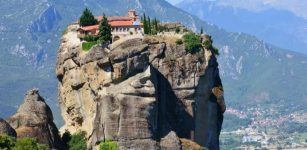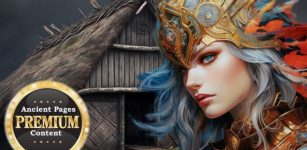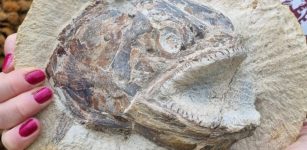The Ruins Of Pennard Castle And The Tale Of Faeries’ Curse
A. Sutherland - AncientPages.com - Very little is known about Pennard Castle, a ruined castle near the village of Pennard in the Gower Peninsula in South Wales.
The ruins we see today are all left from Pennard Castle. Its history records are primarily lost in the mists of time because it was a period of political turmoil and an uneasy rule of Anglo-Norman barons.
Castell Pennard. There was a previous earth and wood ringwork castle here built early C12 which was superseded in late C13/early C14 by this stone castle. It commanded an excellent position on the edge of Pennard Pill and was matched by another on the opposite side of the valley, but the castle was inexpertly constructed for military defence. After only a hundred years or so it surrendered to a natural foe, the encroaching wind-borne sands. Legend tells that this was the result of the castle's Norman baron disrupting the revels of the Telwyth teg (fairy folk) down on the beach below. Image credit: ceridwen - CC BY-SA 2.0
A small settlement grew up near the Castle, complete with a church, but there is no sign of it now. Only part of a single wall of the church remains standing.
Dated to the 12th century, the Castle was a rather primitive construction. It consisted of wooden fortifications with a bank, ditch around it, and a primitive stone hall, probably built by Henry de Beaumont, first earl of Warwick, who was granted the lordship of Gower.
Of this early fortification, only the hall's foundations are still visible. Later, the Castle was rebuilt, and a small settlement grew up around the Castle, complete with a church.
When the Pennard Castle was abandoned is unknown, but by 1400, no one was there. No one else ever moved, probably due to its deteriorating condition.
What happened to the Castle and the village? As far as ancient records say, Pennard was never attacked, so why was it deserted? The only possible answer lies in dunes that enveloped the entire area and destroyed the soft rock walls of the Castle, causing living conditions unacceptable.
Pennard Castle. Image credit: Eiona Roberts - CC BY 2.0
It's unknown exactly when Pennard was abandoned, but the church was out of use in 1532.
Legend has it that the Castle's owner once refused the local fairies the right to dance at his wedding party. The upset little people sent a massive storm, destroying the building.
The owner was a Baron so fierce and ruthless that everyone feared him. His strength and bravery in battle were known throughout Wales. His enemies never dared venture near his Castle. It was here that he passed his time in drunkenness and debauchery.
War was in the land, and fearing defeat, the King of Gwynedd, Lord of Snowdonia, sent a messenger to the Baron asking him for help. Eager for a fight and wise enough to see an opportunity for profit, the Baron returned the messenger to the King, demanding his reward.
The King was desperate; his enemies were collecting a large army in the east, and he knew his throne would soon be lost. The messenger quickly returned to the Baron's Castle.
"Well," bellowed the Baron. "What does your Lord and Master offer that I may take his side in this matter?" "My master commands me to give you this," he replied, handing the Baron a scroll with a royal seal.
Beaumont created a ringwork fort surrounded by a bank and ditch, with a stone hall within the earthworks. Of this early fortification, only the hall's foundations are still visible.
The Baron won this important battle and rode to Caernarfon castle and there were great celebrations. The King was still determined to reward his mighty warrior. The King guaranteed to reward the Baron with anything he desired if they won the battle.
"What prize shall you have? he asked the Baron, ready to empty his treasury. "Name it, and it is yours." "You have a beautiful daughter, Sire. She will be my reward," answered the Baron.
The King was disappointed; this was not the bargain he expected, but he had already given his word. The King's daughter was beautiful but also a bit simple and impressionable.
Some claimed that her friends were fairies and that she spent her days talking to them. The Baron's demand flattered her, and the princess agreed to wed the Baron. With a sad heart, the King bade her farewell. Reaching Pennard Castle, the Baron ordered a great feast. The feasting soon turned to drunkenness with men and women. Drunk and lustful, the Baron grabbed the princess and carried her to his chambers, intent on having her. There was no talk of a wedding ceremony first. Intoxicated and overwhelmed by the Baron's strength, she submitted.
Suddenly, there was a cry from the guards. "An army comes to Pennard." The Baron ran to the battlements and saw a horde of lanterns advancing toward his Castle. He grabbed his sword and ran out to meet the attackers. He cut right and left, slashing and swinging as he ran through the invaders. His sword grew heavy as he fought and his arms burned with pain from the exertion, until he could no longer resist. The lights swarmed around him, and he drove on hacking and chopping.
Finally, he slumped to his knees, exhausted, looking at the blink lights dancing around him and imagining he saw the faint glimmer of gossamer wings.
The same night a mountain of sand blew in from the sea. It was no army but a host of fairies coming to share in the wedding celebrations. As he watched, the wind blew the fairies away, and a violent storm started to batter his Castle. The Castle, the Baron, and the Princess vanished.
Written by – A. Sutherland - AncientPages.com Senior Staff Writer
Updated on October 12, 2023
Copyright © AncientPages.com All rights reserved. This material may not be published, broadcast, rewritten or redistributed in whole or part without the express written permission of AncientPages.com
Expand for referencesMore From Ancient Pages
-
 Huge Ancient Ceramic Workshop With Hundreds Of Stunning Artifacts Solves An Archaeological Mystery In Israel
Archaeology | Dec 14, 2020
Huge Ancient Ceramic Workshop With Hundreds Of Stunning Artifacts Solves An Archaeological Mystery In Israel
Archaeology | Dec 14, 2020 -
 Mysterious Kaali Crater And The Holy Lake – Sacred Ancient Places In Estonia
Featured Stories | Jan 19, 2018
Mysterious Kaali Crater And The Holy Lake – Sacred Ancient Places In Estonia
Featured Stories | Jan 19, 2018 -
 Lady Trieu: Fierce Warrior, Rebel, Freedom Fighter And National Hero In Vietnam
Featured Stories | Feb 26, 2019
Lady Trieu: Fierce Warrior, Rebel, Freedom Fighter And National Hero In Vietnam
Featured Stories | Feb 26, 2019 -
 Arch Of Triumph In 2000-Year-Old City Of Palmyra – Destroyed
Archaeology | Oct 5, 2015
Arch Of Triumph In 2000-Year-Old City Of Palmyra – Destroyed
Archaeology | Oct 5, 2015 -
 Yuki-Onna ‘Lady Of The Snow’: A Female Demon And Symbol Of Death In Japanese Mythology
Featured Stories | Mar 7, 2019
Yuki-Onna ‘Lady Of The Snow’: A Female Demon And Symbol Of Death In Japanese Mythology
Featured Stories | Mar 7, 2019 -
 Rare Iron- And Viking-Age Mortuary Houses Discovered In Norway
Archaeology | Aug 27, 2024
Rare Iron- And Viking-Age Mortuary Houses Discovered In Norway
Archaeology | Aug 27, 2024 -
 Bad King John’s Lost Treasure May Be Hidden Near The Walpole Marsh In The Fenlands – Archaeologists Say
Archaeology | Mar 27, 2024
Bad King John’s Lost Treasure May Be Hidden Near The Walpole Marsh In The Fenlands – Archaeologists Say
Archaeology | Mar 27, 2024 -
 Unusual Double Temple Of Kom Ombo Dedicated To Crocodile God Sobek And Falcon-Headed God Horus
Featured Stories | Mar 14, 2016
Unusual Double Temple Of Kom Ombo Dedicated To Crocodile God Sobek And Falcon-Headed God Horus
Featured Stories | Mar 14, 2016 -
 Magnificent Meteora And ‘Suspended In The Air’ Greek Monasteries
Featured Stories | May 5, 2021
Magnificent Meteora And ‘Suspended In The Air’ Greek Monasteries
Featured Stories | May 5, 2021 -
 Mystery Of The Copper Age ‘Ivory Lady’ Solved
Archaeology | Jul 6, 2023
Mystery Of The Copper Age ‘Ivory Lady’ Solved
Archaeology | Jul 6, 2023 -
 Hamingja – Norse Guardian Spirit Bringing Good Luck From Generation To Generation
Myths & Legends | May 20, 2024
Hamingja – Norse Guardian Spirit Bringing Good Luck From Generation To Generation
Myths & Legends | May 20, 2024 -
 Blood Discovered On The Shroud Of Turin – Strand Of Jesus’ DNA Can Be Found – Researchers Say
Archaeology | Jul 19, 2017
Blood Discovered On The Shroud Of Turin – Strand Of Jesus’ DNA Can Be Found – Researchers Say
Archaeology | Jul 19, 2017 -
 Unraveling The Mystery Of How Our Ancestors Created The First Spoken Words
Archaeology | Dec 6, 2021
Unraveling The Mystery Of How Our Ancestors Created The First Spoken Words
Archaeology | Dec 6, 2021 -
 Unexplained Mystery Of A Painting That Has Been Labeled ‘Evil’
Featured Stories | Oct 3, 2018
Unexplained Mystery Of A Painting That Has Been Labeled ‘Evil’
Featured Stories | Oct 3, 2018 -
 God Loki – Trickster, Elusive And Fascinating Member Of The Norse Pantheon
Featured Stories | Sep 14, 2017
God Loki – Trickster, Elusive And Fascinating Member Of The Norse Pantheon
Featured Stories | Sep 14, 2017 -
 Mystery Of The Scientist Who ‘Saw’ A Fire From Miles Away
Featured Stories | Nov 1, 2020
Mystery Of The Scientist Who ‘Saw’ A Fire From Miles Away
Featured Stories | Nov 1, 2020 -
 Long-Lost Wreck Of Crusader Ship And Gold Coins Discovered
Archaeology | Mar 14, 2017
Long-Lost Wreck Of Crusader Ship And Gold Coins Discovered
Archaeology | Mar 14, 2017 -
 Secret Passageways And Caves Beneath UK’s City Of Nottingham
Featured Stories | Feb 14, 2023
Secret Passageways And Caves Beneath UK’s City Of Nottingham
Featured Stories | Feb 14, 2023 -
 Strange Tales Of Loughareema – The Vanishing Lake Where People Are Lost
Featured Stories | Jan 8, 2022
Strange Tales Of Loughareema – The Vanishing Lake Where People Are Lost
Featured Stories | Jan 8, 2022 -
 183-Million-Year-Old Fossils: Jurassic Marine World In A Farmer’s Field
Fossils | Jul 31, 2022
183-Million-Year-Old Fossils: Jurassic Marine World In A Farmer’s Field
Fossils | Jul 31, 2022


